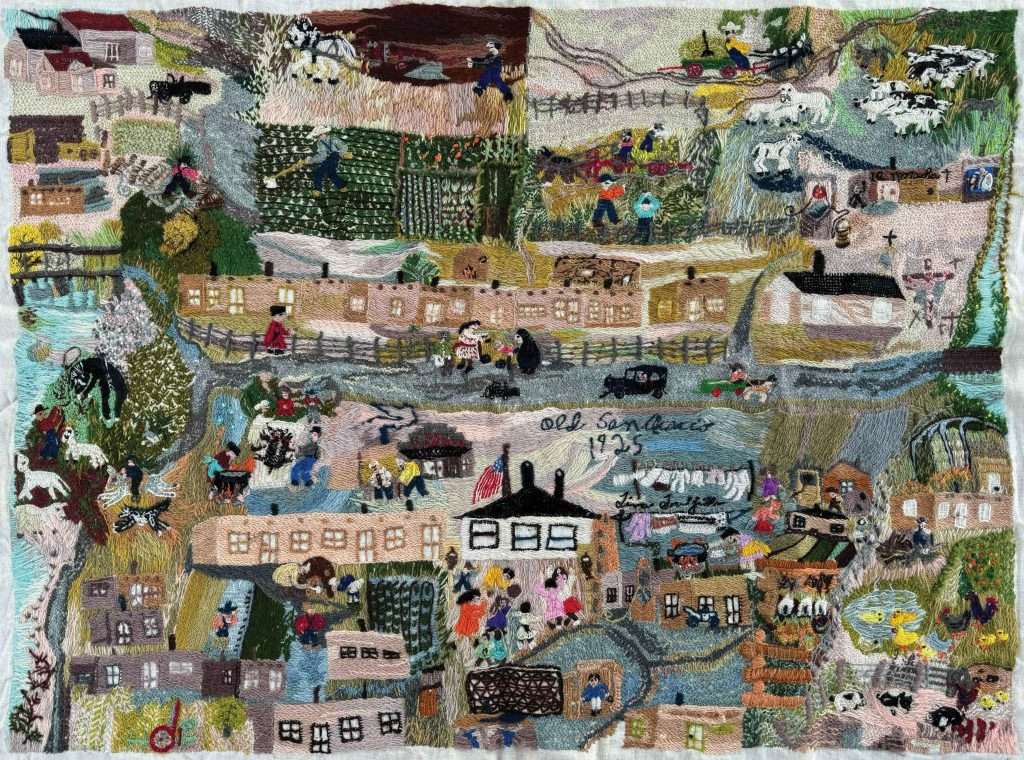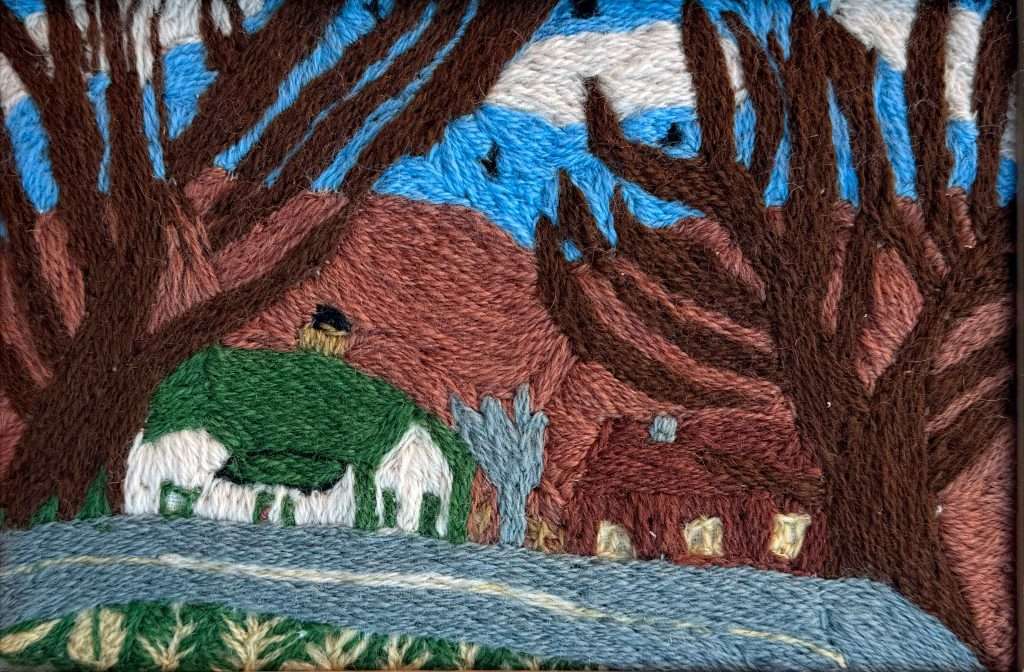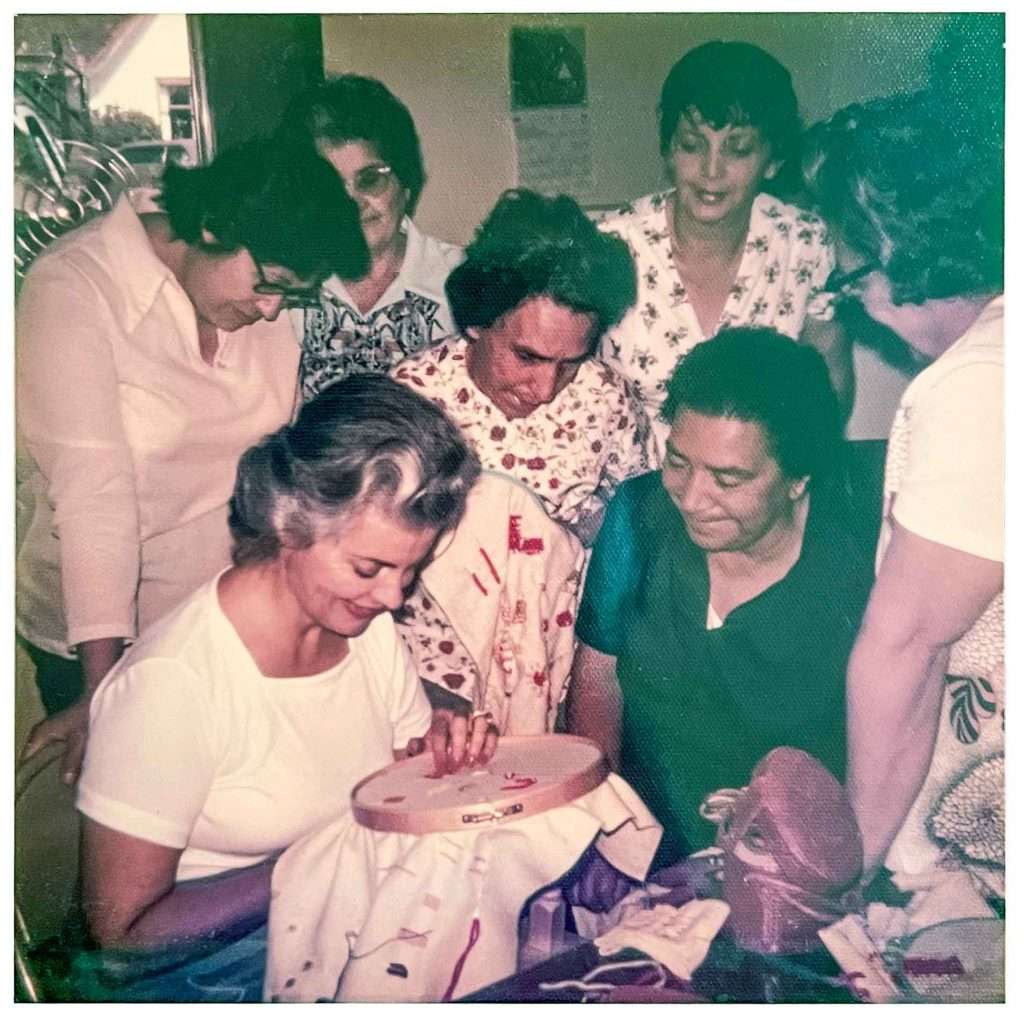A history of colcha in Saguache County
By HEART of Saguache
Colcha embroidery became an important cultural tradition in Saguache County when a revival took place in the 1970s to develop a cottage industry for low-income, rural women. Through a serpentine path of joy and disillusionment, participating artists and families came to treasure these artworks as heirlooms and expressions of community identity.
Local landscapes are a common motif in SLV colcha embroidery as artists used their daily lives as inspiration.
The programs didn’t result in economic prosperity and they became a touchstone in the complex history of the interplay between intentions and impacts in development initiatives.
SLV colcha embroidery is shaped by Spanish, Anglo, and Indigenous craft traditions. Colcha is a Spanish word for bed covering, but its usage in the Southwest refers to the wool embroidery that was used to adorn blankets during Spanish settlement. Examples of colcha embroidery from this period are defined by their abstract patterns, religious symbols, and ornamental designs of flora and fauna. These pieces were influenced by textiles from Asia, the Middle East, Europe, and Native and Hispanic weavings of the region. After the Mexican-American War, the prevalence of colcha embroidery diminished as commercially produced textiles and quilting traditions from the East made their way out West. Throughout the 20th century there were efforts to revitalize the craft in the region, notably in Northern New Mexico.

In the late 1960s in St. Louis, Missouri, nuns in the Congregation of Divine Providence revisited their founding documents following the Second Vatican Council and were compelled to serve the disenfranchised. In 1970, the sisters moved to Center, and began working with community members to organize for Hispanic representation on boards, voting rights, childcare, health care, and economic opportunities for people living in poverty. In 1973, Lois Lawler (formerly Sister Alice Lawler, CDP) and a group of women established the Artes del Valle craft cooperative, inspired by Appalachian craft co-ops. With a grant from the Presbyterian Church, Artes del Valle renovated the abandoned church in La Garita, converting it into the San Juan Arts Center, where they produced and sold Hispanic crafts.
Through Artes del Valle Sister Alice met Marianne Stoller, a Colorado College anthropologist who took her to visit craft practitioners in small towns across New Mexico. They visited Villanueva, where Chilean artist Carmen Benavente Orrego-Salas was working with locals on the creation of a tapestry commemorating America’s bicentennial. Benavente had a successful project in Chile teaching women to make embroidered depictions of everyday rural life. Sales of this art enabled some artists to purchase homes. Sister Alice arranged for Benavente to teach a workshop in Center. Sister Alice talked with the women about their knowledge of embroidery, and some had memories that as children they would gather wool stuck to barbed wire fences for their mothers to spin, using the yarn to adorn cloths around the house. Artes de Valle took trips to Denver and Santa Fe to see examples in museum collections, as none owned colcha embroideries.
Artists in Center focused on embroidering ornamentation of local flora and Hispanic motifs onto fabric that was then sewn into skirts, vests, and handbags by a co-op seamstress. Artes del Valle artists included Betsy Baca, Melissa Carter, Lucille Espinoza, Lupita Espinoza, Fran Jaramillo, Ora Jaramillo, Luella LeBlanc, Lucy Lovato, Emilia Lucero, Emilianita Lujan, Lydia Martinez, Nora Martinez, Cleo Salas, Adeline Sanchez, Clorinda Sanchez, Elaine Sanchez, Sally Sanchez, Stella Sanchez, Margaret Sandoval, Jeanette Trujillo, Clara Valdez, Grace Vigil, Ursula Vigil, and Bertie Vargas.

Artes del Valle sustained itself through grants and the salaries the sisters made working other jobs. Profits went to the artists, but the money was insufficient for the women to afford their own supplies or contribute significantly to their economic health. The project was maintained through the administrative labor of the nuns for many years, but eventually shut down after the sisters moved away from Center. A collectively made colcha embroidery altar cloth is displayed for special occasions at the La Garita Church today.
In Saguache the colcha embroidery revival was initiated by the Denver based nonprofit Virginia Neal Blue Resource Center for Colorado Women (VNB), whose mission was to provide job training for low-income, rural people. They hired Benavente to teach embroidery in San Luis and Saguache. Saguache artist Patsy Garcia organized the participants, and remembers “this woman called me and said, ‘a woman from Chile will be teaching embroidery, we need a lot of women and we need a lot of commitment for sure.’ I was so excited… I called every woman in town. We would meet once a week and sew all afternoon and visit.”
The Saguache colcha embroidery program brought together artists including Mary Baker, Cathy Baxter, Margaret ‘Mugs’ Batchelder, Mary Anne Gallegos, Patsy Garcia, Margie Gurule, Yvonne Halburian, Brenda Lovato, Sandra Lovato, Virginia ‘Bena’ Lovato, Mary Pacheco, Sadie Pacheco, Marcella Quintana, Nettie Quintana, Brenda Rowe Heckathorne, Francis Russell, Lupe Tafoya, Nyla Thompson Orvis, Evelyn Trujillo, Tiva Trujillo, and Delores Worley. Benavente was very influential in her teachings with the group, which chose to focus on making pictorial artworks. Tiva Trujillo reflected in the 1979 documentary Los Testamentos that Carmen said “the picture is more important if you draw it your own way. It’s a true picture because nobody else will be able to draw what you draw. You’re not copying or anything, it’s just what you see. She said draw your past. Your present. What is really real.”

In the 1970s, the Saguache economy was struggling, and many residents were affected by a lack of well-paid jobs. VNB provided artists with materials and a small hourly wage for their labor. More than 400 artworks were produced Valley-wide during this time. VNB organized exhibitions and sales and kept the proceeds. VNB was supported by grant funds, so when the funds ran out, the program ended. Artists were not given information on where the artworks went and saw little income from the program, leading to lingering dissatisfaction mixed in with the love of the art they created and the time they spent together working on their embroideries.
In 1993, a homecoming celebration took place for a beloved quilt depicting local architecture that was made by the stitching group La Costura de Saguache. VBN donated the quilt to the community at the request of Delores Worley, who worked persistently to bring it home. Today the quilt hangs in the Colorado Room of the Saguache Public Library.
In 2018, the grassroots community organization HEART of Saguache partnered with the art space The Range to initiate the SLV Colcha Embroidery Project to locate artworks, organize exhibitions and workshops, and support artists throughout the Valley. There is an upcoming opportunity to learn the art on Sunday June 2 at the Saguache County Museum.
Today colcha embroidery in the SLV is a beloved artform with many new practitioners drawn to its colorful and complex history. The artworks embody community storytelling and folklore, while pointing to a checkerboard history of exploitation and economic precarity dating back to colonization.
The artworks exemplify the unique talents and memories of artists that have made Saguache County their home and hold great promise for the continuation of the tradition, with a hope for more art to stay in the community for residents and visitors to experience in the place it was made.


